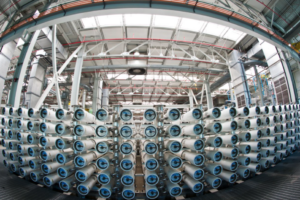Would you wake up one morning and drink a glass of water that your neighbour down the street used a few days ago to take a shower?
That’s the reality for some water-stressed communities around the world, including parts of California.
The state may be one of the world’s most affluent and robust economies, but people living in SoCal just don’t have the water supply to keep up with a population larger than all of Canada’s.

Prof. Ron Hofmann is part of University of Toronto’s Drinking Water Research Group, and he believes water reuse will be a key lifeline as cities around the world continue to experience water shortages.
“We mostly just treat water and dump it back into the environment, but now we’re thinking of treating the water really well and sending it right back in to the community as drinking water. And that’s the way of the future.”
So how do you treat wastewater so it’s safe enough to consume directly from a tap? Hofmann explains that it’s about having multiple barriers.
Water that’s treated the traditional way by a municipal wastewater treatment plant is then pushed through reverse osmosis membranes and hit with ultraviolet light and strong chemicals in a process called advanced oxidation, to kill any remaining harmful microorganisms and to destroy potentially toxic chemicals.
And while we have the methods to clean the water, there are still more barriers to overcome, says Hofmann.
“Ten years ago, we didn’t have the technology to turn toilet water into drinking water and now that we do, it’s about overcoming the political and psychological obstacles.”
Hofmann says it’s important for people to realize that people have been unwittingly participating in water reuse for a long time.

“Take the Colorado River for example. Somebody’s sewage upstream becomes somebody’s drinking water source downstream. Do the math and you can prove that at some point about 90% of the river flow has gone through people’s homes. People all over the world have been drinking treated sewage or sewage water forever. This is not new.”
The cost of water reuse is currently about five times more expensive than traditional water treatment methods, but there’s other benefits for municipalities to embrace this technology, even if they currently have the luxury of a virtually unlimited fresh water supply.
“Toronto takes water out of Lake Ontario and pumps it up hill, dozens of kilometres, only to let it flow back down the lake via gravity. That’s wasting a lot of energy, whereas with water reuse, we could pump it uphill once and recirculate it within that community and we might save a tonne of energy and cut down on greenhouse gas emissions.”
There’s no plan for Canadian cities to adopt this technology anytime soon, but according to Hofmann, the future is bright and already we’re seeing attitudes about water reuse in California shifting from negative to positive.
“Apparently at a community meeting not too long ago, there was discussions about how the recycled wastewater was going to a more affluent part of town and the people living in the more impoverished part of town were asking why the rich people were getting all the recycled water. That’s how far things have come.”
BACK TO WORLD WATER DAY STORIES
By David Goldberg